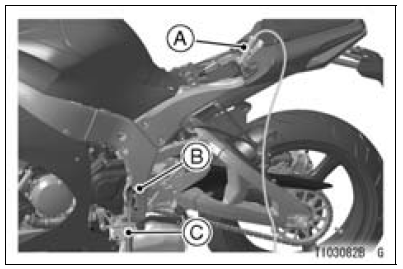

If your motorcycle battery is “run down”, it should be removed and charged. If this is not practical, a 12 volt booster battery and jumper cables may be used to start the engine.
DANGER
Battery acid generates hydrogen gas which is flammable and explosive under certain conditions.
It is present within a battery at all times, even in a discharged condition. Keep all flames and sparks (cigarettes) away from the battery. Wear eye protection when working with a battery. In the event of battery acid contact with skin, eyes, or clothing, wash the affected areas immediately with water for at least 5 minutes. Seek medical attention.
Connecting Jumper Cables

A. From Booster Battery Positive (+) Terminal
B. Swingarm Pivot
C. From Booster Battery Negative (–) Terminal
DANGER
Batteries contain sulfuric acid that can cause burns and produce hydrogen gas which is highly explosive. Do not make this last connection at the fuel system or battery. Take care not to touch the positive and negative cables together, and do not lean over the battery when making this last connection. Do not connect to a frozen battery. It could explode. Do not reverse polarity by connecting positive (+) to negative (–), or a battery explosion and serious damage to the electrical system may occur.
NOTICE
Do not operate the starter continuously for more than 5 seconds or the starter will overheat and the battery power will drop temporarily. Wait 15 seconds between each operation of the starter to let it cool and the battery power recover.
 Starting the Engine
Starting the Engine Moving Off
Moving OffRear Wheel Rotation Sensor Signal (Service Code 24)
Rear Wheel Rotation Sensor Signal Inspection
The rear wheel rotation sensor sends the signal to the
ECU through the KIBS hydraulic unit (KIBS equipped
models). For other than KIBS equipped models, the
signal is sent directly to the ECU.
The ECU uses the rear wheel rotation sensor signal for
mo ...
Air Intake Duct Assembly (Other than US, CA and CAL Models)
Install the seals [A] as shown in the figure.
Fit the projections [A] of the air intake valve to the hole [B]
of the air intake ducts.
Tighten:
Torque - Air Intake Duct Assembly Screws: 1.5 N·m (0.15
kgf·m, 13 in·lb)
Hang the shaft [A] to the air intake valve securely ...
Special Tools
Fork Oil Level Gauge:
57001-1290
Vacuum Gauge:
57001-1369
Hand Tester:
57001-1394
Throttle Sensor Setting Adapter #1:
57001-1400
Peak Voltage Adapter:
57001-1415
Needle Adapter Set:
57001-1457
Throttle Sensor Setting Adapter:
57001-1538
Measuring Adapter:
57001-1700
...